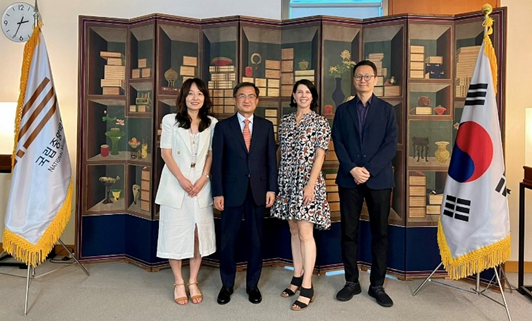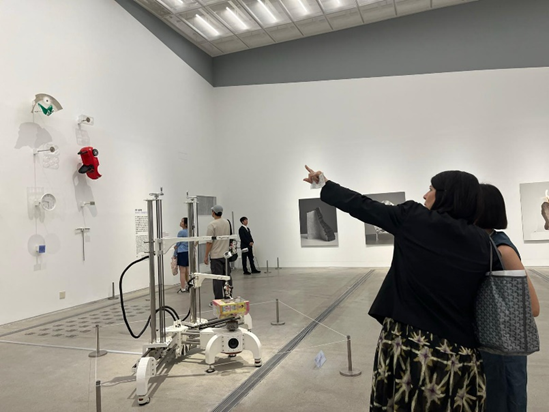SI Global deepens South Korean ties
South Korea may be a popular tourist destination, renowned for its cuisine and culture, but Aviva Rosenthal came back from a recent visit with more than souvenirs.
Days after returning from a whirlwind five-day trip to Seoul, South Korea, Aviva Rosenthal – director of SI’s Office of Global Affairs, or SI Global for short – reflected on the warm hospitality of her hosts, The Ministry of Culture, Sports and Tourism of the Republic of Korea.
Rosenthal had been selected as a “K-Fellow” to help foster greater understanding of Korean culture and develop deeper cultural ties between SI and MCST.

From left, National Museum of Korea Curator Shin Soyeon; Director General Kim Jae Hong; SI Global Director Aviva Rosenthal; and Yoon Sang-deok, head of the Archaeology and History Division. (Photo courtesy of Aviva Ro0senthal)
Visits to two or three museums and cultural organizations per day were punctuated by meals of Korea’s storied and complex cuisine. “I ate my way through the place,” Rosenthal says with a laugh, recalling traditional delicacies such as lotus root prepared several ways: deep-fried, sliced into salad, in a savory sauce.
SI Global’s Mission
Yet Rosenthal’s trip – and indeed, SI Global’s mission – goes far beyond breaking bread with bigwigs. These kinds of in-person gatherings – halted over the first couple years of the pandemic – plant the seeds for rich collaboration whose impacts can ripple out across years and miles and build on existing relationships already started by units and can be leveraged by others across the Institution
“I had really warm and productive meetings with so many people” she says. In the post-pandemic era, it was a stark reminder that nothing can ever fully replace “traveling to meet people face to face and see different types of museums and understand how other people think and work.”
The trip stemmed from 2023’s South Korean state visit to Washington. It was during that visit from President Yoon Suk Yeol and his wife, First Lady Kim Keon-hee, that officials at MCST signed a Memorandum of Understanding with the Smithsonian that outlined the contours of an expanded partnership between the US and ROK.
Before and since the state visit, “we have been working on finding ways to activate the MOU,” Rosenthal says, adding that First Lady Kim gave remarks at the MOU signing ceremony, a demonstration of the importance given to building cultural ties with the Smithsonian.
Creating meaningful global exchange programs
Since she became director of SI Global in March 2020, Rosenthal and her team have built and managed a slate of what she calls “really interesting, deep and meaningful global exchange programs around shared topics and challenges” with many units across SI, with an eye toward fostering the sharing of best practices in curatorial, conservation, exhibit and program design, and much more, as well as the opportunity to find possible areas of overlap and further partnership.
“As a central unit at SI, we support everybody,” she explains. “Our office is the front door to [non-SI organizations such as] the foreign Diplomatic Corps, the US State Department, USAID, UNESCO” and the like.
Spending time with museum and cultural sector counterparts in other countries “helps us understand what other museums are excited about and what we can learn from them as they describe the goals and vision for what they wish to accomplish,” she says. “Once we have gotten past the getting-to-know-you stage, we home in on specific opportunities for potential collaboration” all across SI. (Ed. Note: please contact Aviva Rosenthal if you have an idea for possible collaboration with a museum outside the US.}

Touring the Seoul Museum of Art. (Photo courtesy of Aviva Rosenthal)
Investing in preservation
South Korea’s investment in and commitment to preserving and interpreting its culture, art and history is “mind-blowing,” Rosenthal says.
“The level of sophistication and investment in their national museums – the architecture (including the construction quality of the physical plant), the volume of collections, public programs and exhibitions– is so innovative and cutting-edge. ROK’s government funds it all, so they are not burdened with seeking outside funders.
“What I walked away with is this awareness that the South Korean government [prioritizes] making Korean art and history and culture accessible to its people,” viewing it as a core aspect of national identity,” Rosenthal says. “That investment then offers a wealth of opportunities for partnership, exchange, and collaboration across all aspects of the Smithsonian.”
“We share the Koreans’ vision to both protect our own cultural and scientific heritage and history and to interpret and connect it with our citizens to make it relevant for the next generation,” she adds.
Personal relationships are invaluable, Rosenthal says – and so are the institutional relationships that can spring forth from the personal ones.
“When we establish and steward those [broader] relationships at the national Ministry level, we can leverage them for the benefit of individual units, PI and curators’ research interests to elevate opportunities that would have been more difficult without the institutional connections already established.”
Posted: 18 December 2024
-
Categories:
Collaboration , Education, Access & Outreach , Feature Stories



